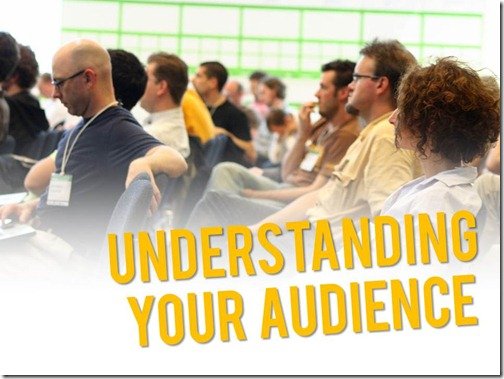Who is your audience?
Presentation is made to be presented in front of the audience. A specific audience. Every presentation has its own specific and different audience. You need to deal with them differently.
Understanding your audience—people who will come to attend and listen to you—will help you to understand how they process the information and what they want to hear from a presentation.
This is very important, not only in constructing the content, but also in making adjustments to the entire design of the presentation, to help you influencing the audience effectively.
If we look at the three interrelated components in a presentation, one of the most important key in a presentation is the audience. You are there to give a presentation and create a communication process for them.
Recognizing Your Audience is Very Important
Understanding your audience is a key to create and deliver a great presentation. You cannot offer something interesting to your audience unless you know who they are. You have to know what they need and want from your presentation.
Its hard to expect an effective communication process if you don’t know their point of view when they are listening to you.
As presenter, you will find it difficult to relate yourself with them. Your audience will also have difficulties to understand you.
It can create a situation that will leads to frustration: You are frustrated because you can not make them understand, and they are frustrated because it is difficult to understand you.
You will not encounter this situation if you know your audience well. Your job will be much easier, because you know exactly what they want. You can choose which information should get across and which one is not necessary. Convincing the audience will becomes much easier too, because you understand what factors that influences them to take action.
Recognizing the audience is not just knowing that they are your boss, co-workers, students, or a group of society. Knowing the audience includes knowing their name, their position in the organization, what decision they make, and what they need from your presentation. And, more importantly, why they come to your presentation.
Recognize your audience. This is what distinguishes a great presenter from an ordinary one.
The first thing a great presenter will do is identifying their audience. Then use these valuable information to design a relevant and effective presentation.
Ordinary presenters, that often deliver a monotonous and ineffective presentation feel that it is not important to find out in detail who their audience is. They simply give the same presentation to different audiences.
Every communication is unique. And presentation is a communication. Your audience and the situation surrounding the communication process will influence it’s effectiveness.
Who is the Audience of your presentation?
Before starting to prepare a presentation, find out who will present in your presentation. More information you have will help your readiness to act in a presentation.
In The Art of War, Sun Tzu said, “He who knows his enemy and himself well will not be defeated in a hundred battles. He who knows himself but not his enemy, will have an even chance of victory. He who does not know himself and his enemy, is bound to suffer defeat in all battles.”
In short, Sun Tzu said: “A person who recognize himself, recognize his opponent and recognize the battlefield, will win in every battle.”
A presentation is a battlefield of communications. You want the audience to accept and understand your message as good as possible.
That’s why you have to recognize your strength as a presenter, recognize your opponent (audience and what they expect), and recognize the battlefield (media communication, situation surrounding the presentation, and the specific approach that you may need). With all of this you are ready to win every presentation.
What You Need To Know From the Audience?
We have summarized here several things you need to know about your audience:
- Who will present to your presentation?
- What is their position in the organization?
- What is their educational background, or their job?
- What is their level of knowledge about the topic you will deliver?
- What is their learning style?
- What they like to hear and what they don’t?
- What is their purpose in listening to your presentation?
- Why they need to listen to you?
Now, you know why understanding the audience is so crucial in a presentation.
Don’t forget that the first thing you have to do every time you prepare a presentation is recognizing your audience. It will help you a lot in creating content and designing the most appropriate communication for them.


